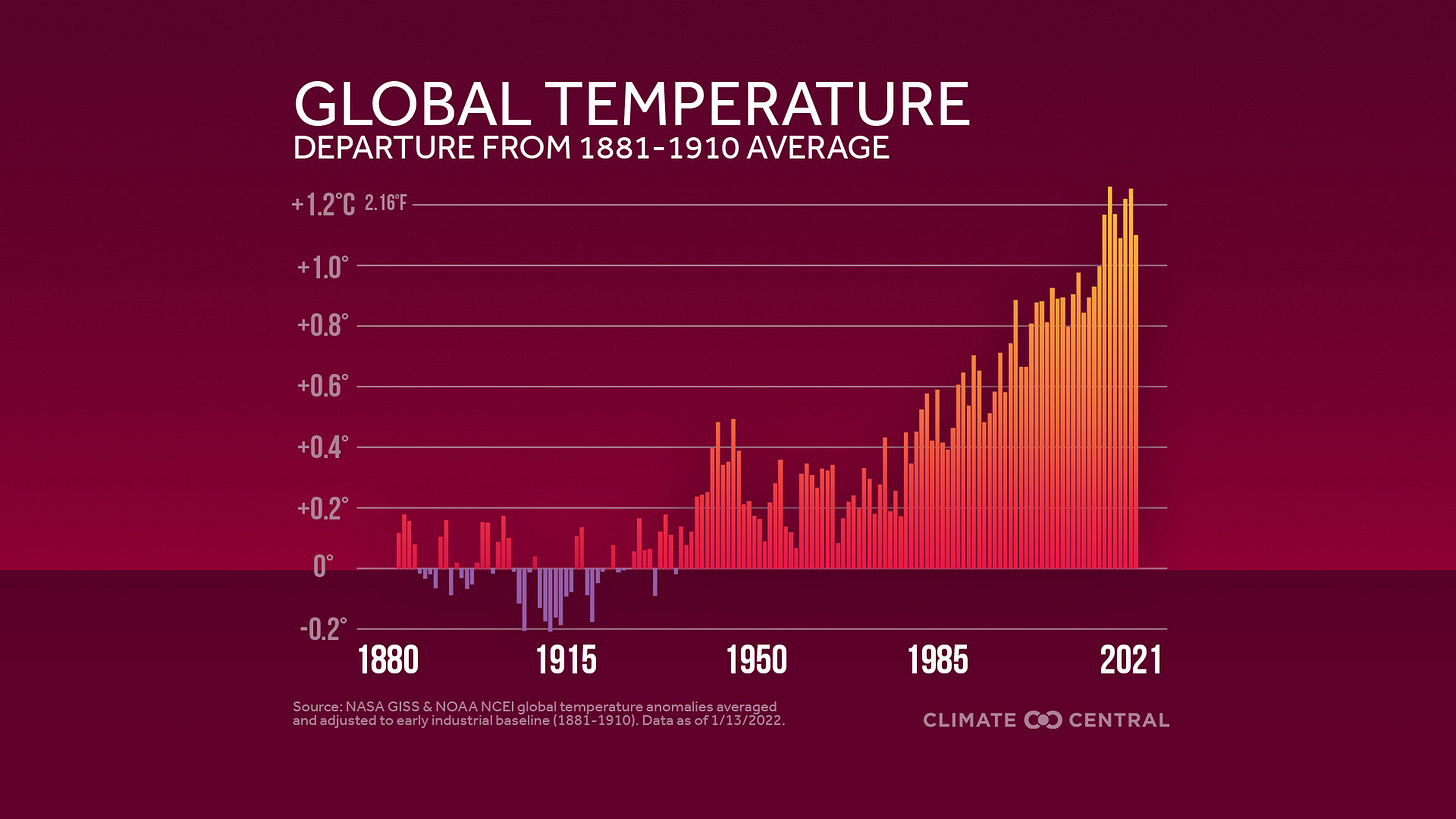
“Courage is the resolve to do well without the assurance of a happy ending.”
—Climate scientist Kate Marvel here
To measure global warming, one needs a baseline. The IPCC has defined “pre-industrial temperature” as the average of the years 1850-1900, partly because these are the first years of the instrumental record and partly for political reasons: The higher the baseline, the less we’ll be moved to action, which benefits the nations controlling the IPCC.
I’ve long maintained that what the IPCC called the pre-industrial baseline is way too high. For example, in a 2017 piece, “Global Warming Has Reached Nearly +1.5°C Already,” I argued that there’s about 0.2°C of undeclared warming in the accepted baseline number.
After all, the Industrial Age is universally said to start with the invention of James Watt’s steam engine in the mid-1700s. (The patent date is 1769.) More than half a century of steam-powered, coal-fueled “industry” occurred before 1850.
The conclusion, that we’re even farther behind the Paris agreement schedule, is sobering. Again, from 2017, almost a decade ago:
Two points:
The Paris climate agreement had hoped to hold global warming to no more than +1.5°C above the pre-Industrial temperature. This is not going to happen. We're almost at that point now, and we'll breach that goal in just a few years.
From the chart at the top, note that the two-year rise from 2014 to 2016 was, converted to Celsius, +0.1 degrees all on its own. Three more two-year periods like this and global temperatures will cross +2°C, the extremely generous IPCC "magic barrier" after which, in lay language, "we're mainly screwed."
This doesn't mean we should do nothing to adapt to the blow — it's always necessary and wise to adapt, even if the start of adaptation is very late. But the window to mitigate — to lessen the blow — is rapidly closing. Remember, once the social and political chaos reaches critical mass (once there's too much of it), global warming will run to its natural conclusion.
Elsewhere I've predicted the "natural conclusion," barring conscious intervention, to be global warming of +7°C before humans are forced to stop emitting so much CO2, either through greatly diminished numbers, or greatly diminished technology, or both.
Again, this was written in 2017. (My +7°C prediction from more than a decade ago (2013) is here, along with the reasoning behind it.)
New Evidence for a Lower ‘Pre-Industrial Baseline’
The period 1850-1900 was chosen in part because of the instrumental record. But not long ago, two UK scientists, Andrew Jarvis and Piers Forster, devised a well-constructed proxy for pre-industrial temperature that uses CO2 concentrations in East Antarctica ice cores.
The method is complex, but not incomprehensible. Their original paper was published in Nature Geoscience, one of the premier climate publications:
• Estimated human-induced warming from a linear temperature and atmospheric CO2 relationship
They applied their method both to the instrumental data from 1850 to 1900 and to the years from 13 CE through the 1800s. The correlation between their method’s temperature predictions and the instrumental record is very high, with the added benefit that theirs has a greater degree of accuracy (a narrower uncertainty band). This gives confidence about their pre-instrumental conclusions.
‘Pre-Industrial’ Temperatures and Existing Global Warming
Their conclusions are clear. Baked into the 1850-1900 data is additional human-caused warming. From a report on the paper at Lancaster University:
The authors find that when measured from this earlier more accurate definition of pre-industrial time, the long-term human contribution to warming was 1.49 °C ± 0.11 °C in 2023 and is now above 1.5 °C. This reveals that there is almost 0.2 °C of warming within the 1850-1900 baseline currently being used to define the warming.
In a later interview Jarvis said that using CO2 data from October, their method shows human-induced warming had hit +1.53°C in 2024.
What to Do? What We Would Do Anyway. Live Courageously.
Since we’re not going to stop spewing carbon, not under anyone’s rule…
...we’re headed to what I above called the “natural conclusion.” I hope you can guess what that is.
As to what to do next, consider: Since global warming has clearly accelerated, and since we’ve limited time and money to use in response, we should shift our efforts from mitigation (making the world less unfriendly) to adaptation (making ourselves more resilient).
At this point, undoing the crisis is lost energy. But if we can’t change the world, we can still adapt to it , a task that can be attempted at any level, as individuals, families, towns, or nationally.
And, as in every day of our fragile lives, we can face what’s coming with courage. As the ancient American philosopher Tom Waits wrote (Willie Nelson's dramatic reading here):
All your cryin’ don’t do no good
Come on up to the house
Come down off the cross, we can use the wood
Come on up to the house
We can definitely use the wood, and another hand to help carry it.




If we include the Bronze and Iron ages and why wouldn't we, we're at least at 2.29C.
https://kevinhester.live/2023/06/05/current-climate-path-will-lead-to-collapse-of-life-on-earth/
A 7ºC atmospheric temperature rise will kill billions. Or rather, it could, but allowing for pandemics to rage without any attempt to distribute or develop vaccines might do away with the billions faster.
It will be a race that our spiteful MAGA administration is working full-time to organize.